Antenna Types – Monopole Antenna
February 4, 2019
Monopole Antenna
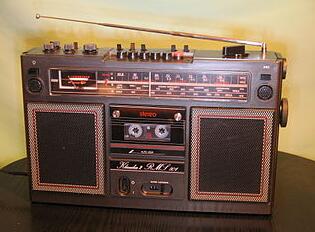
Quarter-wave whip antenna on an FM radio for 88-108 MHz
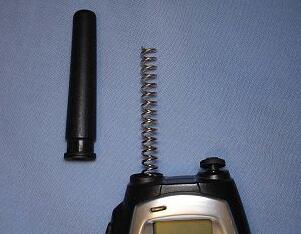
Rubber Ducky antenna on UHF 446 MHz walkie talkie with rubber cover removed.
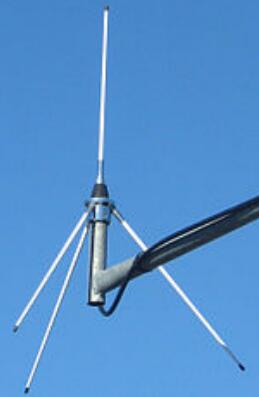
VHF ground plane antenna
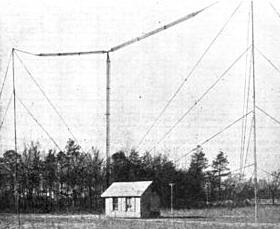
T antenna of amateur radio station, 80 ft high, used at 1.5 MHz.
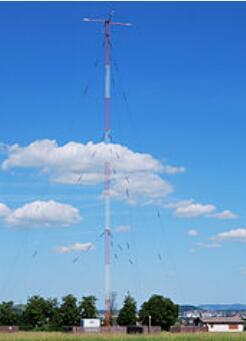
Mast radiator antenna of medium wave AM radio station, Germany
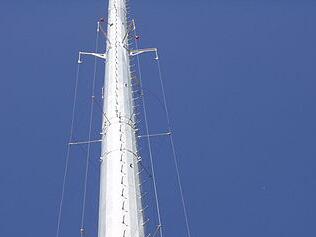
Folded unipole with skirt wires connected at a midpoint on the tower
A monopole antenna consists of a single conductor such as a metal rod, usually mounted over the ground or an artificial conducting surface (a so-called ground plane). One side of the feedline from the receiver or transmitter is connected to the conductor, and the other side to ground or the artificial ground plane. The radio waves reflected from the ground plane seem to come from an image antenna below the ground, with the monopole and its image forming a dipole, so the monopole antenna has a radiation pattern identical to the top half of the pattern of a similar dipole antenna. Since all of the equivalent dipole’s radiation is concentrated in a half-space, the antenna has twice (3 dB increase of) the gain of a similar dipole, not considering losses in the ground plane.
The most common form is the quarter-wave monopole which is one-quarter of a wavelength long and has a gain of 5.12 dBi when mounted over a ground plane. Monopoles have an omnidirectional radiation pattern, so they are used for broad coverage of an area, and have vertical polarization. The ground waves used for broadcasting at low frequencies must be vertically polarized, so large vertical monopole antennas are used for broadcasting in the MF, LF, and VLF bands. Small monopoles are used as nondirectional antennas on portable radios in the HF, VHF, and UHF bands.
Whip – Type of antenna used on mobile and portable radios in the VHF and UHF bands such as boom boxes, consists of a flexible rod, often made of telescoping segments.
Rubber Ducky – Most common antenna used on portable two way radios and cordless phones due to its compactness, consists of an electrically short wire helix. The helix adds inductance to cancel the capacitive reactance of the short radiator, making it resonant. Very low gain.
Ground plane – a whip antenna with several rods extending horizontally from base of whip attached to the ground side of the feedline. Since whips are mounted above ground, the horizontal rods form an artificial ground plane under the antenna to increase its gain. Used as base station antennas for land mobile radio systems such as police, ambulance and taxi dispatchers.
Mast radiator – A radio tower in which the tower structure itself serves as the antenna. Common form of transmitting antenna for AM radio stations and other MF and LF transmitters. At its base the tower is usually, but not necessarily, mounted on a ceramic insulator to isolate it from the ground.
Folded unipole antenna – is a modified mast antenna, usually grounded at its base, augmented by one or several parallel wires called “skirt wires” that attach to the mast part-way up the antenna. The skirt wires can attach at any height between part-way up and the top of the mast. One or more of the skirt wires is fed with the signal, similar to a gamma match. The number and relative thickness of the mast and the skirt wires adjusts the impedance magnitude at the feedpoint. Further, the fed wire(s) and the mast form a vertically aligned loop which inductively loads the antenna, with the inductance controlled by the height of the attachment point.
T and inverted L – Consist of a long horizontal wire suspended between two towers with insulators, with a vertical wire hanging down from it, attached to a feedline to the receiver or transmitter. Used on LF and VLF bands. The vertical wire serves as the radiator. Since at these frequencies the vertical wire is electrically short, much shorter than a quarter wavelength, the horizontal wire(s) serve as a capacitive “hat” to increase the current in the vertical radiator, increasing the gain. Very narrow bandwidth, requires loading coil to tune out any remaining capacitive reactance. Requires low resistance ground.
Inverted F – Combines the advantages of the compactness of inverted-L antenna, and the good matching of the F-type antenna. The antenna is grounded at the base and fed at some intermediate point. The position of the feed point determines the antenna impedance. Thus, matching can be achieved without the need for a separate matching network.
Umbrella – Very large wire transmitting antennas used on VLF bands. Consists of a central mast radiator tower attached at the top to multiple wires extending out radially from the mast to ground, like a tent or umbrella, insulated at the ends. Extremely narrow bandwidth, requires large loading coil and low resistance counterpoise ground. Used for long range military communications.
[from wikipedia]
